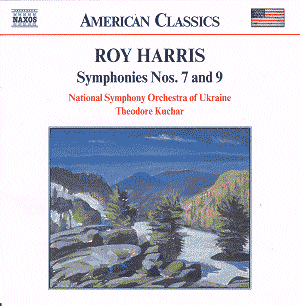This disc is yet another winner in the Naxos American
Classics series. Many of the greatest successes of this imprint (the
Piston Violin Concertos recording springs immediately to mind) have
emanated from this source and this one is as accomplished as we have
come to expect. It is especially valuable in that it brings us music
of an important figure who is underrepresented in the record catalogues,
especially on the European side of the Atlantic. Portrayed as something
of a one hit wonder (his Third Symphony of 1938 is admittedly
a masterpiece and one of (if not the) greatest of all American
essays in the form), nothing could be further from the truth in Harris's
case. He wrote thirteen symphonies, including the choral Folksong
Symphony and the programmatic Gettysburg, and the two Kuchar
has selected to record here are indeed well chosen. The Seventh
Symphony was completed in 1952 but revised three years later.
In it Harris revisits the single movement form that served him so well
in the aforementioned Third Symphony, with a similar playing
time too (just under twenty minutes). The music also has a similar feel
of organic growth, the much-remarked evocation of the wide-open spaces
of the American wilderness, and liberal use of brass and timpani. It
is typical Harris in that one remembers more the overall atmosphere
and poetry it carries with it than its particular melodies; that said
it is music that is far more immediate and understandable than most
of the large-scale orchestral works of say William Schuman (a pupil
of Harris), Carl Ruggles or Ives (in experimental rather than traditional
mode). It is probably worth noting at this juncture that Harris, although
he studied in Paris with Boulanger, as did many of his contemporaries,
his mature music (unlike, say, that of Copland or Virgil Thomson) was
largely untouched by either jazz or neo-classicism. I suppose that the
obvious predictable model for the Seventh Symphony is the equivalent
work of Sibelius and there are numerous qualities about Harris's compositions
that do suggest an affiliation with the Finnish genius. The strong feel
for nature, the general serious/lofty tone (another aspect that makes
it stand apart from much contemporaneous Americana), the pared down,
often spare orchestration and the condensation (distillation?) of ideas.
The Ninth Symphony is less typical in some ways.
It is rather more extended than many of his mature works, running to
half an hour, in three movements with the final one further subdivided.
Each movement and section are headed by words taken from Walt Whitman,
a figure who looms large in the works of many early twentieth century
composers (including Holst, Delius and Vaughan Williams as well as many
of their American contemporaries). The first, "We the people",
uses percussion to full effect and is more rhythmic in nature than Harris
tends usually to be. The second, "…to form a more perfect Union",
however, is quintessential Harris, with an elegiac, almost valedictory
feel to it. Whereas the strings and woodwind dominate the second movement,
in the third, "…to promote the general welfare", brass and percussion
reassert themselves and the overall mood is one of optimism. The symphony
ends on a high and once again reaffirms Roy Harris's place at the very
pinnacle of the twentieth century American symphonic tradition.
The short JFK tribute piece is also archetypal
Harris, a serious but not over-solemn tribute highlighting the strings
and, towards the end of the piece, tubular bells (anyone looking for
the same sort of aural balm dispensed by Pärt and Gorecki might
be somewhat disappointed though!).
Although valid claims may be made on behalf of Copland,
Piston and Schuman, as far as this listener is concerned, Harris's are
somewhat greater and it is a sobering thought indeed that, apart from
Bernstein's classic recording of the Third Symphony, this new
disc is the only one featuring his other orchestral music that is widely
available (i.e. likely to be encountered by chance in HMV etc.) in this
country. It is a fine CD anyway but, under these circumstances, it must
be regarded as an essential purchase for anyone remotely interested
in the twentieth century symphony.
Neil Horner


